|
Some notes on the Dukedog class
by Russ Elliott
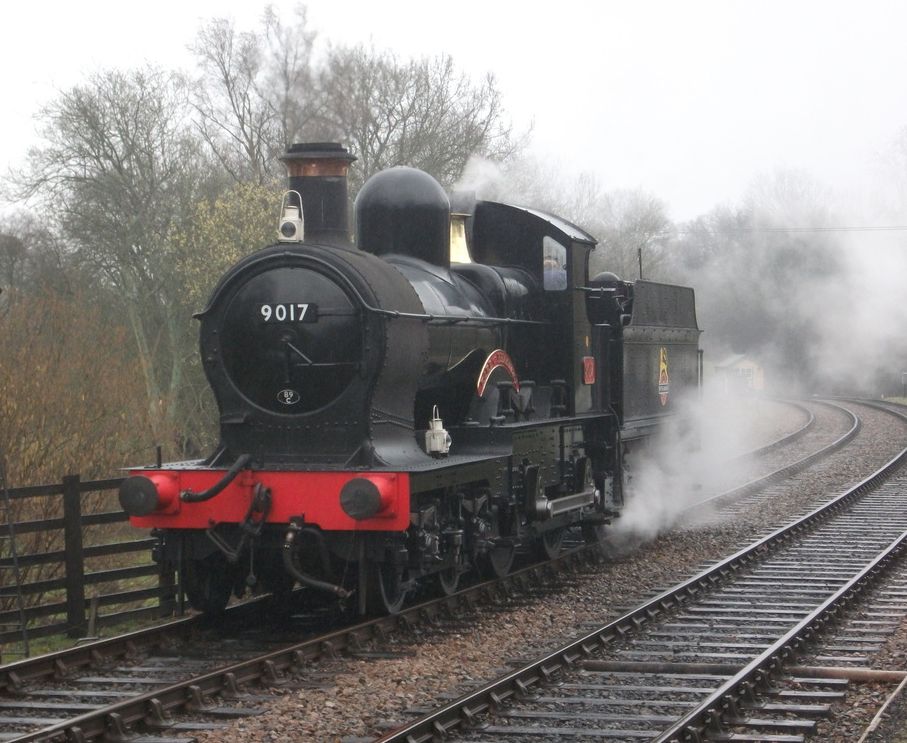
Perhaps dreaming of Talerdigg in the rain, 9017 busies herself on the Bluebell Railway in 2011. Photo copyright and permission of Chris Thomas.
Introduction
Bachmann's Dukedog appeared in 2014. These notes are intended to help potential purchasers make an informed choice, and to give some details of the many variations in this class.
Bachmann have introduced five versions:
- 9003 in GWR green, the tender insignia being 'G W R' (Bachmann 31-087DC)
- 9017 in BR black, early emblem (Bachmann 31-086)
- 9022 in weathered BR black, early emblem (Bachmann 31-085)
- 3214 in GWR green, shirtbutton insignia (Bachmann 31-089)
- 9028 in BR black, early emblem (Bachmann 31-088)
Prototype overview
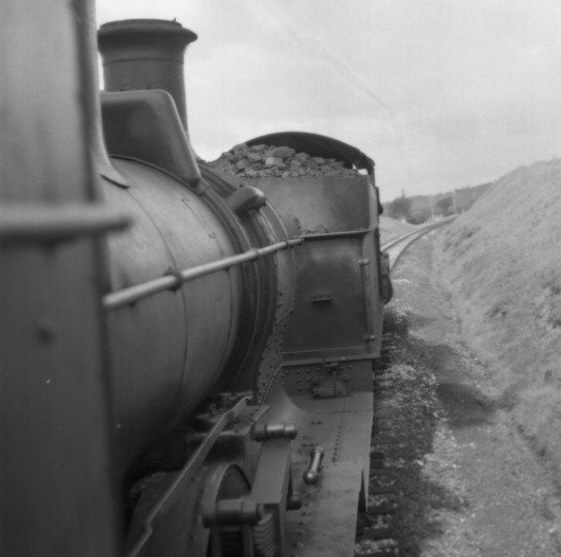
On Talerdigg, a driver's eye view from a Dukedog, with a Mogul leading
The class was created in response to the need for locomotives with an axleload more suitable for lighter lines, especially the former Cambrian routes into mid-Wales, the 'blue route' Bulldogs being considered to be too heavy for the Cambrian main line. The prototype of the class, 3265 'Tre Pol and Pen', appeared in early 1930, but the remainder of the Dukedogs, or 'Earls' as they were officially known, were introduced between April 1936 and November 1939. All the locos were rebuilds, being a combination of a Bulldog frame and the upperparts of a Duke 1. They were designed to work with Churchward 3500g tenders, and the cab sidesheets of the locos were flared out to match the bodywidth of those tenders.
3265 was something of an anomaly, allegedly (by many standard texts) having 3'2" bogie wheels rather than the standard 3'8" wheels fitted to the rest of the class, although there now seems to be considerable doubt whether the smaller wheels were ever carried, and no apparent reason why they should have been required. (The most likely explanation is that 3'8" was misread at some stage as 38".) 3265 had a non-standard cab, with no flare to the rear of the side sheets.
The first twenty of the production Dukedogs had names allocated, and the first 13 were actually fitted with nameplates, but these were removed in June 1937 and applied to Castles 5043–62. The whole class was renumbered by the GWR in July/August 1946 into the 90xx series, to prevent confusion with the 32xx series of the '2251' Collett Goods engines. The 90xx renumbering included the eleven surviving Dukes 2, and it is most likely the renumbering would have been done at local sheds, with engines continuing to carry whatever livery they were in at the time.
1 For the preserved 9017/3217, accounts differ as to which Duke(s) were involved.
2 9054, 9064, 9065, 9072, 9073, 9076, 9083, 9084, 9087, 9089, 9091.
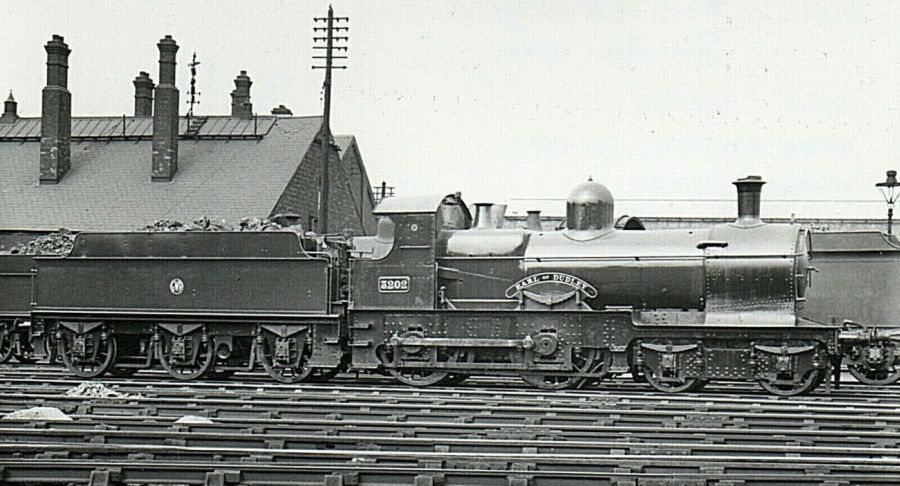
3202, ex-works at Swindon in 1936
Work and allocation
Apart from pairs of locos allocated to work the Didcot, Newbury and Southampton line during 1936–1948 and the ex-M&SWJR line during 1936–1957, and four locos shedded at Bristol Bath Road in 1953–4, and a pair of locos (9008 and 9010) allocated to St Blazey c 1950, the main stamping ground for the Dukedogs was the ex-Cambrian lines west of Shrewsbury.
Livery development
With the exception of 3265, which appeared in 1930 with GREAT WESTERN on its tender, all the class first appeared in shirtbutton livery.
In WWII, the power and route restriction indicators were lowered from their position high up on the cabside to just above the numberplate. The indicators remained in that position after WWII.
Bachmann's 9003 was renumbered from 3203 in July 1946. It is not known whether 9003 ever appeared in green. There is however a photograph in the Jim Russell locos book of 3216 in shiny green with G W R on its tender, which indicates it got repainted between late 1945 and August 1946, when it was renumbered to 9016.
For many if not most of the class, the first proper repaint was probably into unlined BR black livery after nationalisation.
Detail variations
There are many detail variations in the class:
- topfeed styles, where fitted (boiler swaps could vary this provision);
- three cab window styles;
- two coupling rod styles;
- chimneys (three different types: thin 'Duke' parallel, fat parallel, and tapered cast iron); - 3200–8 were fitted with tapered cast-iron chimneys when built, with the remainder of the class fitted with the parallel-sided coppercap pattern; most of 3200–8 probably acquired the parallel-sided type later, although in some cases not until WWII;
- sandboxes 'below' or enlarged ones 'above' the footplate (this was dictated by the particular donating Bulldog frame);
- different types of bogie, this being dictated by the particular donating Bulldog chassis;
- different buffer styles (which were not necessarily the same style as the buffer on the tender);
- different tenders.
Whistle position, whistle shields, the height of the handrail on the cabside, and the position of the upper front lamp iron also varied. The usual position for the front lamp bracket was on top of the smokebox, but some of the class had them lowered to be on the smokebox door, probably from c 1952.
On some locos, a horizontal line of rivets was present on the side of the smokebox a couple of foot or so below the handrail line. On others, the number of these rivets was far fewer. On the as-preserved 9017, the smokebox wrapper has varied, from a full line of rivets to none at all. The pattern of the inclined set of rivets on the lower of the smokebox side varied.
The most common tender attached to the Dukedogs was the Churchward 3500g type, with snaphead rivets, but flush-riveted tenders could be seen, particularly in earlier years. Several also ran with the smaller 3000g type, e.g. 9002, in 1953 (note the tender in 1949 lined mixed traffic black livery), and 9019 and 9026 ran with the small 2500g type for a spell. Tenders were subject to change.
Here are some online pictures illustrating many of the detail variations of the class, and bear out the need for a good dated photograph of your chosen prototype:
- 3203, in 1937, tapered chimney, shirtbutton, standard cab windows, parallel loco buffers, fishbelly rods
- 3205, in 1938, fat parallel chimney, standard cab windows, sandboxes 'on top', parallel loco buffers, fluted rods
- 3210, in mid-1943, fat parallel chimney, G W R on tender, standard cab windows, parallel loco buffers, fluted rods, body colour unknown
- 3212 'Earl of Eldon', straight from the shops in 1936, fat parallel chimney, standard cab windows, tapered loco buffers, fluted rods
- 3218, in 1938, fat parallel chimney, small topfeed, standard cab windows, insignia not visible but certainly shirtbutton, parallel loco buffers, fluted rods
- 3265 'Tre Pol and Pen' c 1936: 3000g tender, straight-cut 'eyebrow' windows, parallel rods, tapered chimney, sandboxes below the footplate, Collett parallel buffers
- 9000, in March 1954: 3000g tender, standard cab windows, parallel rods, fat parallel chimney, large topfeed, tapered loco buffers, also here in November 1952
- 9001, in 1953, thin parallel 'Duke' chimney, standard cab windows, parallel loco buffers, fluted rods, BR black
- 9004, late period, fat parallel chimney, large topfeed, standard cab windows, tapered loco buffers, fishbelly rods, also here in May 1959, also here in May 1955
- 9004, undated, fat parallel chimney, tall topfeed, standard cab windows, tapered loco buffers, fishbelly rods, see also here, in store at Wellington shed, February 1960, shortly before withdrawal
- 9005, November 1952, fat parallel chimney, standard cab windows, tapered buffers, fluted rods, sandboxes 'on top', also here June 1958, where it has acquired a different smokebox wrapper
- 9008, in 1951, fat parallel chimney, standard cab windows, sandboxes 'on top', tapered loco buffers, fluted rods, BR black
- 9012, fat parallel chimney, standard cab windows, tapered loco buffers, fluted rods, November 1952, also here in 1955
- 9013, in July 1958, fat parallel chimney, standard cab windows, fishbelly rods
- 9014, April 1960, fat parallel chimney, standard cab windows, tapered loco buffers, tall topfeed, fluted rods, BR black, see also here, April 1960
- 9015, in April 1955, fat parallel chimney, curved 'eyebrow' cab windows, tapered loco buffers, BR black, see also here in April 1955, see also here, on the Swindon scrap line shortly after withdrawal
- 9015, undated, but late, fat parallel chimney, 'eyebrow' cab windows, parallel loco buffers, fluted rods
- 9017, August 1955, fat parallel chimney, standard cab windows, tapered loco buffers, fluted rods
- 9018, undated, fat parallel chimney, standard cab windows, parallel loco buffers, fishbelly rods, BR black livery, possibly with red-background numberplates, also here in 1958
- 9021, September 1957, fat parallel chimney, standard cab windows, tapered loco buffers, fluted rods, large topfeed, BR black livery, also here April 1958, but with no topfeed, and a different smokebox wrapper
- 9022, early 1950s, fat parallel chimney, standard cab windows, large topfeed, tapered loco buffers, fluted rods, BR black livery, but note the absence of the topfeed in a probably earlier state
- 9023, April 1954, fat parallel chimney, standard cab windows, tapered loco buffers, fishbelly rods (probably), BR black livery
- 9024, September 1957, fat parallel chimney, fishbelly rods, large topfeed, 3000g tender
- 9025, tapered chimney, large topfeed, BR black livery c 1956
- 9028, in 1953, fat parallel chimney, standard cab windows, tapered loco buffers, fluted rods
There are many online pictures of the preserved 9017, which is based at the Bluebell Railway.
A note on the Bachmann model
Bachmann's 9017 is based on its 1955 appearance when shedded at Machynlleth in 1955, with a flush-riveted tender. (9017 as preserved has run with the flush-riveted tender it ended its BR days with, and later a newer snaphead-riveted tender, the latter being its current state of preservation. Both of these tenders came from withdrawn Moguls, probably 4305 and 6389 respectively.)
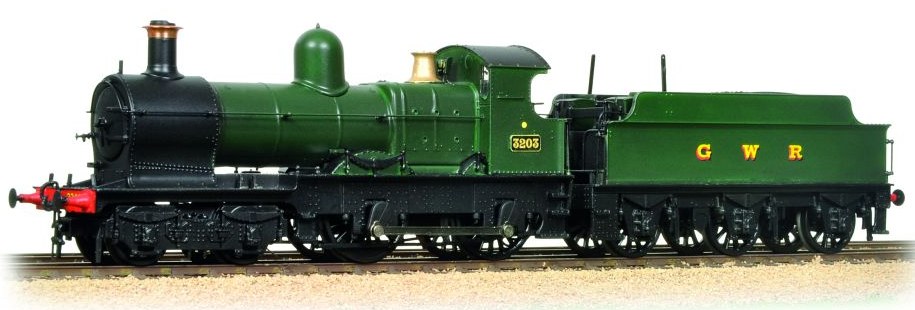
Bachmann's 3203 in pre-July 1946 guise. Given the priorities and scarce resources available at Swindon during WWII, it is improbable that many of the Dukedogs received the new insignia during the war, and if they had been repainted during the war, it is almost certain that they would have been outshopped in black, as was the norm at that time for all engines except Castles and Kings.
Shed allocations and withdrawal dates
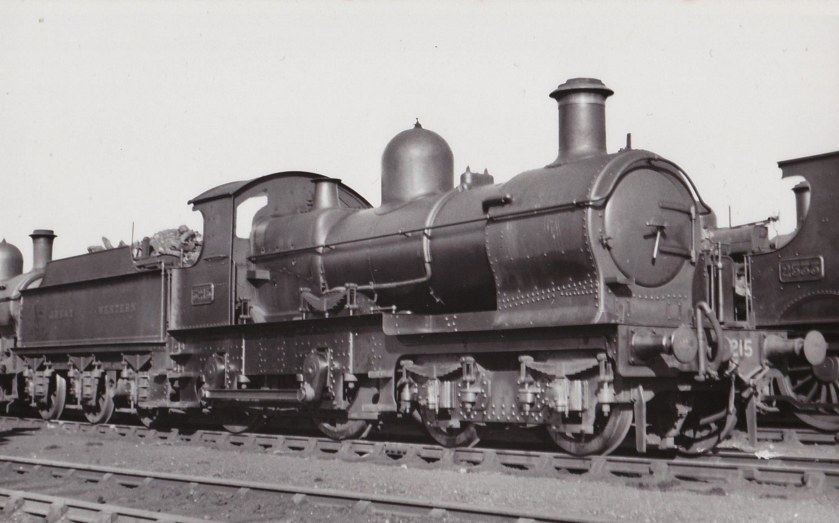
3215, with a topfeed, at Didcot in 1938
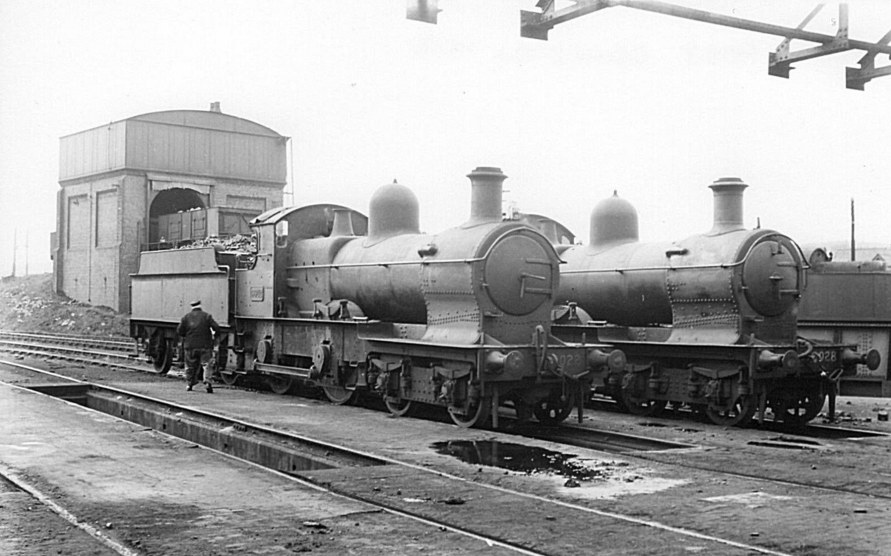
9022 and 9028 at Oswestry, c 1950
Shed allocations given below reflect a combination of data in Great Western Archive and BRDatabase.
| Number |
1936 shed allocation |
January 1948
shed allocation |
Intermediate BR
shed allocation(s) |
Last shed
allocation |
Withdrawn |
| 3200/9000 |
Oswestry |
Machynlleth |
- |
Machynlleth |
March 1955 |
| 3201/9001 |
Oswestry |
Oswestry |
- |
Oswestry |
April 1954 |
| 3202/9002 |
Aberystwyth |
Aberystwyth |
- |
Aberystwyth |
May 1954 |
| 3203/9003 |
Oswestry |
Oswestry |
- |
Machynlleth |
October 1955 |
| 3204/9004 |
Machynlleth |
Machynlleth |
Croes Newydd (July 1957) |
Shrewsbury 1 |
June 1960 |
| 3205/9005 |
Machynlleth |
Machynlleth |
Oswestry (July 1956) |
Oswestry |
July 1959 |
| 3206/9006 |
Didcot |
Didcot |
- |
Didcot |
August 1948 |
| 3207/9007 |
Stratford-upon-Avon |
Tyseley |
- |
Tyseley |
July 1948 |
| 3208/9008 |
Crewe |
Tyseley |
Oswestry (June 1952)
Bristol Bath Road (January 1953)
Camarthen (October 1953)
Machynlleth (July 1954) |
Machynlleth |
July 1957 |
| 3209/9009 |
Cheltenham |
Machynlleth |
- |
Machynlleth |
July 1957 |
| 3210/9010 |
Aberystwyth |
Tyseley |
Oswestry (June 1952)
Bristol Bath Road (January 1953)
Camarthen (October 1953)
Oswestry (June 1954) |
Oswestry |
July 1957 |
| 3211/9011 |
Oswestry |
Swindon |
- |
Swindon |
July 1957 |
| 3212/9012 |
Oswestry |
Machynlleth |
- |
Machynlleth |
July 1957 |
| 3213/9013 |
Aberystwyth |
Aberystwyth |
- |
Machynlleth |
December 1958 |
| 3214/9014 |
Portmadoc |
Pwllheli |
Croes Newydd (July 1957) |
Croes Newydd |
October 1960 |
| 3215/9015 |
Didcot |
Didcot |
Oxford (October 1953)
Machynlleth (July 1956) |
Machynlleth |
June 1960 |
| 3216/9016 |
Oswestry |
Oswestry |
Machynlleth (August 1951)
Oswestry (June 1952)
Bristol Bath Road (January 1953)
Machynlleth (July 1954) |
Machynlleth |
July 1957 |
| 3217/9017 |
Aberystwyth |
Aberystwyth |
- |
Machynlleth |
October 1960
(since preserved) |
| 3218/9018 |
Tyseley |
Swindon |
Oxford (November 1952)
Machynlleth (July 1953)
Oswestry (August 1956)
Machynlleth (September 1956)
Croes Newydd (June 1958)
Oswestry (July 1959) |
Croes Newydd 2 |
June 1960 |
| 3219/9019 |
Gloucester |
Tyseley |
- |
Tyseley |
November 1948 |
| 3220/9020 |
Oswestry |
Oswestry |
Bristol Bath Road (January 1953)
Machynlleth (July 1954) |
Machynlleth |
July 1957 |
| 3221/9021 |
Aberystwyth |
Aberystwyth |
- |
Machynlleth |
December 1958 |
| 3222/9022 |
Oswestry |
Oswestry |
Machynlleth (October 1954) |
Aberystwyth 3 |
August 1957 |
| 3223/9023 |
Andover Junction |
Swindon |
- |
Swindon |
July 1957 |
| 3224/9024 |
Shrewsbury |
Shrewsbury |
- |
Machynlleth |
September 1957 |
| 3225/9025 |
Aberystwyth |
Aberystwyth |
- |
Aberystwyth |
August 1957 |
| 3226/9026 |
Oswestry |
Oswestry |
Machynlleth (June 1952)
Bristol Bath Road (January 1953)
Oswestry (July 1954) |
Oswestry |
August 1957 |
| 3227/9027 |
Aberystwyth |
Machynlleth |
Oswestry (October 1954) |
Oswestry |
August 1957 |
| 3228/9028 |
Oswestry |
Machynlleth |
Machynlleth (August 1951)
Bristol Bath Road (January 1953)
Oswestry (July 1954) |
Croes Newydd |
September 1957 |
1 possibly Croes Newydd
2 possibly Oswestry
3 possibly Machynlleth
|
References
The Locomotives of the Great Western Railway Part Seven, Dean's Larger Tender Engines, N J Allcock, F K Davies, H M Le Fleming, P J T Reed & F J Tabor, The Railway Correspondence and Travel Society
A Pictorial Record of Great Western Engines, Vol. 2 Churchward, Collett & Hawksworth, J H Russell, OPC, 1999. ISBN 0 86093-399-7
Locos Illustrated No 50 'The GWR outside-framed 4-4-0s'
|





